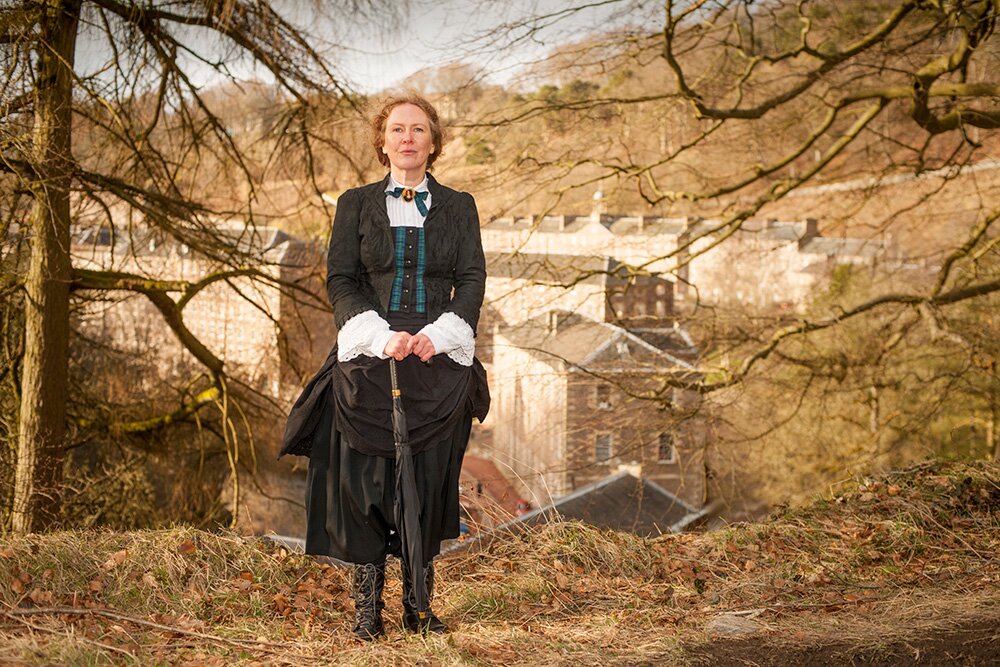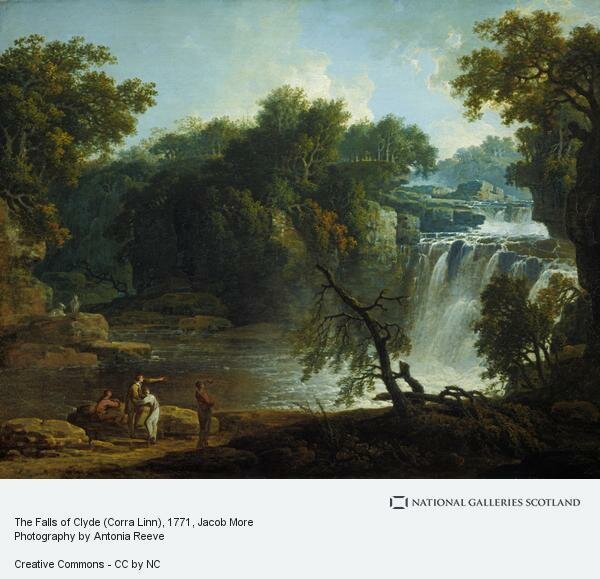Bonnington Pavilion, the 'Hall of Mirrors'
A view of Corra Linn, with a difference
One of the few remnants of the designed landscape of the former Bonnington estate, also known as the ‘hall of mirrors’, the pavilion was constructed in 1708 to provide visitors to the Falls of Clyde with a view of Corra Linn with a difference. According to Black’s Picturesque Tourist of Scotland (1842), mirrors were placed on the ceiling of the room, angled to give the impression that the waters were falling upon the viewer. Whether this was the original purpose is unclear, as the building has undergone alterations over the centuries, and it has fallen into disrepair more than once in its lifetime, and at least by 1769 when it was visited by Thomas Pennant, the Welsh writer and traveller, who described it as “ruinous”.

It is interesting to note that there was a prevailing attitude prior to the 18th century that nature was too ugly and brutal to be looked upon directly, and should only be viewed through a frame or mirror, especially if you were a woman. Perhaps the Bonnington mirrors served a similar purpose too, allowing the aristocratic visitors to the Falls of Clyde to see without gazing directly upon the horrors of nature.
It is also possible, however, that the mirrors served not to detach people from nature, but to immerse them in the experience, and there is a similar building to be found at Dunkled Hermitage; Ossian’s Hall of Mirrors. The mirrors were reputedly placed so that visitors sat with their backs to a window and, once the shutters were opened, created the illusion that they were standing in the middle of the waterfalls.
Dorothy Wordsworth, who also visited the Falls of Clyde, wrote of her experience at Dunkeld; “The waterfall, which we came to see, warned us by a loud roaring that we must expect it; we were first, however, conducted into a small apartment, where the gardener desired us to look at a painting of the figure of Ossian, which, while he was telling us the story of the young artist who performed the work, disappeared, parting in the middle, flying asunder as if by the touch of magic, and lo! we are at the entrance of a splendid room, which was almost dizzy and alive with waterfalls, that tumbled in all directions - the great cascade, which was opposite to the window that faced us, being reflected in innumerable mirrors upon the ceiling and against the walls.”
It’s possible that the hall of mirrors at Corra Linn wasn’t in use when she visited in 1803, as she doesn't make mention of it. However, in her second tour of Scotland in 1822, Wordsworth writes of a summer house; “the surprize made us laugh when we saw Corra Linn above our heads reflected in a mirror, and bustling like suds in a wash tub”.
W. Davidson writes, in his 1828 guide; “This building, which is finely situated upon the summit of the sloping banks which rise above the rocks, and commands a noble view of the cataract below, was erected by Sir James Carmichael of Bonniton, in 1708. Freed from those feelings which agitated his mind, as he sat upon the crazy board below, the stranger can now behold the formidable rushing of the waters. Mirrors are suspended throughout the room, by looking into which the tremendous cataract seems ready to burst forth, and overwhelm him with its foamy flood.”
In 1837 Alexander Archer drew the pavilion seemingly in excellent condition with a sloping roof which is no longer evident. However, Archer did not understand architecture and was known to invent some details in his work. Nevertheless, in the apparent absence of 19th century photogphraphs his record is invaluable.

Photographs from work at the power station surge tank in the 1920s show the roof of the pavilion in relatively good condition, although less ornate than as recorded by Archer almost a century before. Windows appear to still be in place, although the roof does appear to be missing some coping, as well as any top-piece which may be been present before.

In 1840 it appears as if the hall of mirrors is still active, albeit in perhaps a more underwhelming guise that originally intended. John M. Leighton then wrote of Corra Linn, and the view of the falls from the pavilion; “A beautiful though more distant view of this extraordinary scene, may be had from the window of a pavilion, erected by Sir James Carmichael of Bonniton, in 1708, as appears by an inscription over the entrance. Here the spectator, placed far above, on the very summit of the sloping bank which rises from the perpendicular rocks, can contemplate the whole, freed from those feelings of terror with which in nearer situations, he cannot fail to be visited. Indeed, the scene has here more of the effect of a picture, or a beautiful panoramic view; the trees through which it is seen adding their interest to the foreground, or forming as it were a framework at the sides. At the opposite end of the pavilion, a mirror is placed, in which this rich landscape is reflected; and from its position, the spectator is almost led to believe that the cataract is tumbling over his head. Unfortunately, however, the illusion is not made so perfect as it might obviously be. The mirror is neither of sufficient size, a proper shape, or sufficiently concealed in the wall. Were a little expense laid out on this pavilion, which appears to be exactly as it was left by Sir John, 130 years ago, the illusion might be made exceedingly striking.”

The hall of mirrors is even given a brief mention in the 1843 edition of 'Black's Picturesque Tourist of Scotland', which states; "Above is a pavilion...which commands a fine view, and which is filled up with mirrors, so arranged as to give the cataract the appearance of being precipitated upon the spectator." Whether the writer of the passage actually visited, and if so, what they thought of it, is unfortunately not mentioned.
Whether it was intended to spare aristocratic visitors from having to look upon nature, or to provide them with an immersive and abstract experience of the falls, the true appearance and function of the hall of mirrors remains a mystery. What the mirrors looked like and how they were placed is also unknown, as no writer makes a detailed description - it's possible that the authors of some guides did not actually visit and were simply relying on second hand information. Whatever its past, the pavilion still looks upon Corra Linn as a romantic ruin of bygone times, and a reminder of the once grand designed landscape which surrounded it.










